Words of Wisdom - Shastra
& Shastrakaras speak
For Books and shastra downloads see Main Index, under
Books:
Om Namo Bhagavate Vasudevaya
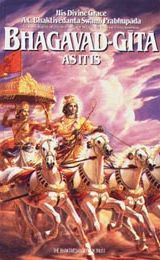

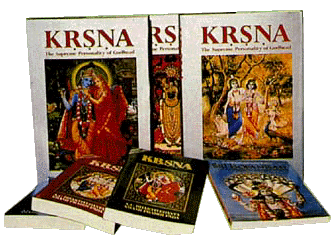
The Complete Works of Srila Prabhupada
All the books, the letters and conversations at your
fingertips
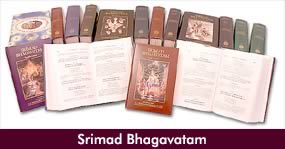

All Srila Prabhupada's books and more on one disk
http://www.vedabase.com




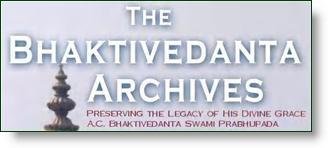
Srila Prabhupada's Audio lectures to listen to on-line:
http://www.hare-krishna.org/srila-prabhupada-lectures.htm
Listen to Srila A.C. Bhaktivedanta Swami Prabhupada on-line
- all 900 of his lectures are available HERE:
http://www.prabhupadavani.org/
Srimad Bhagavatam - the entire lecture series listen and
read along on-line - Narrated by Amala Bhakta dasa:
http://www.prabhupadavani.org/SB_index.html
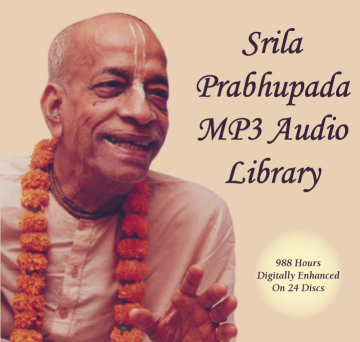
The new enhanced Prabhupada MP3 series
http://www.prabhupada.com/store/store.php?page=product.php&id=MP3AUDIOLIB








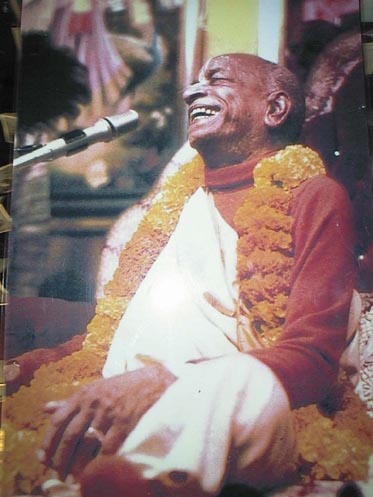
Visit "Prabhupada Connect" for all manner of Prabhupad
Nectar:
http://www.prabhupadaconnect.com/Index.html
Srila Prabhupada's Final Lesson Video - Downloadable and
viewing on-line
http://users.iskconludhiana.com/images/thumbnails.php?album=21


All Srila Prabhupada's original books
available for sale here.

Download all the Hare Krsna teachings which includes
all Vaisnava and
Vedic concepts by visiting one of the sites listed at
the following address.
http://www.geocities.com/suci123/bookdownloadsites1.html
The Bhaktivedanta Book Trust
Srila Prabhupad Memorial Library
http://www.krishna.com/main.php?id=33


33 Books Online Including Srimad Bhagavatam!
http://www.geocities.com/freeprabhupadabooks
The compressed "self extracting" file mentioned is now currently
available for download
http://www.krsnaconsciousness.org/Gauranga/Folio/BhaktivedantaVedabase_DOS.exe

Download or Listen to Prabhupad Bhajans HERE:
http://www.prabhupadavani.org/web/text/Bhajans.html


On-line 1972 McMillan edition - Bhagavad Gita As It Is:
http://www.asitis.com/

Bhagavad Gita AS IT IS on-line through the Tirupathi
Balaji site:
http://www.bhagavad-gita.us/

Bhagavad Gita Study guide on-line book:
http://chantandbehappy.com/gita/studyguide/StudyGuide-main.htm
Bhagavad Gita Study guides by numerous Iskcon devotees
- FREE downloads:
http://www.veda.harekrsna.cz/library/#3

All the Scriptures you'd ever need 4 FREE
http://www.hknet.org.nz/index-books.htm
http://www.hknet.org.nz/DDB.htm
http://www.hknet.org.nz/DDB2.html
last updated 4th August 2003


Srimad Bhagavad Gita AS
IT IS
Bhagavad Gita: Chapter
6 - Dhyana-yoga
TEXT 9
suhrn-mitrary-udasina-
madhyastha-dvesya-bandhusu
sadhusv api ca papesu
sama-buddhir visisyate
WORD FOR WORD
su-hrt--to well-wishers by nature; mitra--benefactors
with affection; ari--enemies; udasina--neutrals between belligerents; madhyastha--mediators
between belligerents; dvesya--the envious; bandhusu--and the relatives
or well-wishers; sadhusu--unto the pious; api--as well as; ca--and; papesu--unto
the sinners; sama-buddhih--having equal intelligence; visisyate--is far
advanced.
TRANSLATION
A person is considered still further advanced when he
regards honest well-wishers, affectionate benefactors, the neutral, mediators,
the envious, friends and enemies, the pious and the sinners all with an
equal mind.
His Divine Grace A.C. Bhaktivedanta Swami Prabhupada
Copyright 1983 The Bhaktivedanta Book Trust International. Used with
permission.

Bhagavad Gita As It Is - http://www.asitis.com/
Bhaktivedanta Vedabase - Bhagavad Gita on-line http://bhagavadgitaasitis.com/
Bhaktivedanta VedaBase: Bhagavad-gita As It Is http://vedabase.net/bg/en
Bhagavad Gita Multi Media Web-version http://chantandbehappy.com/gita/
Listen to Bhagavad Gita on line - http://www.Gitamrta.org
View our Bhagavad Gita Overview:
http://www.hknet.org.nz/BG.html
Archive: http://www.cs.rice.edu/~vivek/btg/archive/
Home Page: http://www.cs.rice.edu/~vivek/btg/
Join Bhagavad Gita eGroups HERE
mailto:bhagavad_gita-owner@egroups.com


Prabhupada Uvacha:
(here's some nectar, sometimes it comes in the form of Srutakirti prabhu's
diary, other times from Govinda dasi's diary, Hari Sauri prabhu's Transcendental
Diary, or sometimes from a letter, or other related source, but still nectar...)
Niyamagraha
After Srila Prabhupada left London, Yamuna continued
to look after Radha and Krsna, following all of Srila Prabhupada's instructions
with great care. Whenever new girls joined, they were quickly engaged by
her in assisting in the Deity worship. As I was more or less in charge
of the temple, she would consult me regularly, and thus I was afforded
an opportunity to also render service to Their Lordships. I was especially
concerned that what-ever standards Prabhupada had established for Their
service should be strictly maintained, and before any changes were introduced
I first took his permission.
When I noticed that many persons were visiting
the temple without being able to have the Deities' darsana during Their
hours of rest, I inquired from Srila Prabhupada what could be done in this
regard. My idea was to have a continuous program of activities in the temple
room, so that whenever guests came they would either hear a lecture or
kirtana, see an arati, and always have fresh prasadam. Srila Prabhupada
liked my proposal. Although normally the Deities were put to rest between
one and four p.m., he said that for preaching purposes the time could be
reduced to only one hour. Krsna had appeared in the Deity form to benedict
the conditioned souls, and if actually they were coming to see Him, He
could minimize His resting time. As Krsna's confidential servitor, Prabhupada
could make this decision on behalf of the Lord. For an ordinary devotee
to have made such a change would have been offensive. But as a bona fide
acarya, Srila Prabhupada was fully competent to judge the needs of each
situation.
In the Caitanya-caritamrta Prabhupada explains
about such adjustments: "It is not necessary that the rules and regulations
followed in India be exactly the same as those in Europe, America, and
other Western countries. Simply imitating without effect is called niyamagraha.
Not following the regulative principles but instead living extravagantly
is also called niyamagraha. The word niyama means 'regulative principles'
and agraha means 'eagerness.' The word agraha means 'not to accept.' We
should not follow regulative principles without an effect, nor should we
fail to accept the regulative principles. What is required is a special
technique according to country, time, and candidate. Without the sanction
of the spiritual master, we should not try to imitate...this is Sri Caitanya
Mahaprabhu's liberal demonstration of the bhakti cult. We should not introduce
anything whimsically, without the sanction of the bona fide spiritual master."
- From the "Servant of the Servant" by HH Tamala
Krsna Goswami
To receive little snippets of nectar like this on a daily basis subscribe
HERE: or If you want to introduce anyone else in reading Srila Prabhupada
Nectars, please send their eMail addresses to mailto:krpamaya_gauranga@hotmail.com
Please Chant:
 Hare
Krishna Hare Krishna Krishna Krishna Hare Hare
Hare
Krishna Hare Krishna Krishna Krishna Hare Hare
 Hare
Rama Hare Rama Rama Rama Hare Hare
Hare
Rama Hare Rama Rama Rama Hare Hare
...................and be Happy

Listen to Srila Prabhupad on-line
....a different lecture, morning walk, conversation or
class daily.
"Looking Toward Unity of Men"
>>> Ref. VedaBase => Room Conversation with Yogi Bhajan -- June 7, 1975,
Honolulu
Listen to the entire lecture on-line:
this lecture is not available on-line
Yogi Bhajan: How are you?
Prabhupada: Not very well.
Yogi Bhajan: You have carried a big load. What is...
Will you be in a position to come to the conference?
Prabhupada: I don't think so. Which conference?
Yogi Bhajan: This Unity of Man Conference.
Prabhupada: Where it is?
Yogi Bhajan: New Mexico. There are about, we have confirmed
sixteen teachers coming from, various people from India. We have confirmation
of people coming all around the world.
Prabhupada: So they have not invited me, I don't think.
Yogi Bhajan: The invitation must have gone.
Prabhupada: Hmm?
Yogi Bhajan: We invited everybody.
Prabhupada: Ah, but I have not received an invitation.
Yogi Bhajan: Oh, it may be on the way.
Prabhupada: Mexico City?
Yogi Bhajan: New Mexico.
Paramahamsa: That's in America. It's one of the states
in America, right next to Texas.
Yogi Bhajan: Yeah. Santa Fe. We have decided that this
is the time for everybody to get together and get their scene together
and merge together.
Prabhupada: They will never. (laughs) You may call all
conferences, hundreds and thousands, but they will never, because there
is no common platform. Godless.
Yogi Bhajan: That is what we are trying to provide.
Prabhupada: But you are trying, that's nice, but it will
be never successful. You can write it down.
Yogi Bhajan: Well, perhaps it is very simple. Somebody
has to break the ice.
Prabhupada: Hmm?
Yogi Bhajan: Somebody has to break the ice. Somebody,
it doesn't matter who. Somebody has to go out and say, "You are welcome.
Come in." And it has shown response. Even the prime minister has agreed
to it. First she was not agreeing. And she is coming in Mexico.
Prabhupada: Indira Gandhi?
Yogi Bhajan: Um hm. She will be there on the 17th and
18th. So we are carrying that spirit.
Prabhupada: The thing is everyone is trying to be united.
That United Nation is for the last twenty years. They started in 1947,
United Nations? Eh?
Paramahamsa: Yeah, '47.
Prabhupada: And it is seventy...
Paramahamsa: Almost thirty years.
Prabhupada: Thirty years. What they have done? All the
best men of the whole world, they are there, but no united, simply disunited.
Common platform, they are not agreeable. They do not accept God.
Yogi Bhajan: Um hm.
Prabhupada: That is the difficulty, no central point.
You have got your own philosophy. I have got my own philosophy. He has
got his own philosophy. Now, how we will agree?
Yogi Bhajan: No, I may not agree with your philosophy,
and you may not agree with my philosophy, but one thing we both have agreed
that you are you, and I am I, and both can have respect and love for each
other. And there has to be a place where everybody should be given that
opportunity.
Prabhupada: That is going on. When I meet you I say,
"Yes sir." You say, "Yes sir." That is all right. That is social etiquette.
But real unity is on the platform of spirit soul. Panditah sama-darsinah
[Bg. 5.18]. Pandita, he is sama-darsina. So panditah means
vidya-vinaya-sampanne
brahmane gavi hastini
suni caiva sva-pake ca
panditah sama-darsinah
[Bg. 5.18]
"A very learned brahmana and a dog and an elephant, a
cow, a candala -- all of them, to a pandita, really learned person, sama-darsinah."
You see? So now how a learned scholar brahmana and a dog can be seen on
equal level? But it can be seen. Panditah sama-darsinah [Bg. 5.18]. It
is on the spiritual platform, that every one of us is spirit soul. We are,
by different karma, we are covered with different material dress. A dog
is also a soul, and a learned brahmana is also a soul. But he is covered
with different body, and he is covered with different body. So one who
does not see the body, he can see on the same level. But one who sees the
body, he cannot see. This is the basic principle of equality. I am seeing
you are Sikh, you are seeing I am Hindu, he is seeing he is Christian,
he is Mohammedan, and so on, so on. And nobody is seeing that nobody is
brahmana. Nobody is seeing nobody is Hindu, nobody is Christian -- he is
pure soul. So that vision, unless one attains, how there can be equality?
There is no possibility.
Yogi Bhajan: Yeah, that's agreed. But...
Prabhupada: So that requires education. Brahma-bhutah
prasannatma na socati na ka... samah sarvesu bhutesu [Bg. 18.54]. When
one is Brahman realized, then he can see equally. But that requires education,
how to become brahma-bhutah. But everyone is sarira-bhutah. Everyone is
thinking, "I am this body." So how it can be possible? So we may attempt,
but it is not possible.
continued.......................
Listen to the entire lecture on-line:
http://prabhupadaradio.com/M3U/Gita/m3u/GT104.m3u
or receive in mailbox and Subscribe HERE:
mailto:lectures-subscribe@prabhupadavani.org
Sravanam kirtanam at:
http://www.PrabhupadaVani.org
© 2001 The Bhaktivedanta Book Trust International. Used with permission.

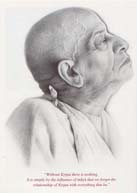
SRILA PRABHUPADA'S QUOTE OF THE DAY
Krishna Consciousness is always dormant in everyone's
heart & it can be awakened simply by service attitude. You are already
allotted a nice service & if you continue this reponsibility anywhere
you live & at the same time chant at least 16 rounds a day you will
do all right in any circumstances.
Letter to Jadurani, Calcutta 1967
Sign-up to receive these quote HERE:
mailto:haribol@pacific.net.sg

Bhaktivedanta Vedabase Network ...
http://vedabase.net/


The Scientific - Mathematical
Proof for God's existence:
http://geocities.com/sector114

http://robot-hosting.com/php/login_nicholas.html
user name = guest
password = guest
(Collection of philosophical and mathematical proofs
for existence of God can be found in this site.)

Scientifically Philosophical Books for the layman
 ...
...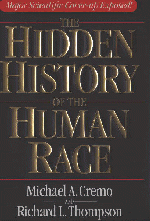 ...
...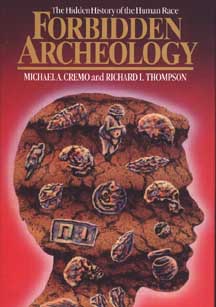 ...
...
Click on any of these books to read more about them and where to get
a copy
or contact your local temple for purchases
sample of Life
comes from Life HERE.pdf

Lotus Imprints - Preserving Prabhupada's Legacy - The
Publishing House of Hari Sauri dasa
http://www.lotusimprints.com/

Quotes from Shastra - scriptures
View using Balaram font
The Advent of Bhagavad Gita

last updated 10th December 2005
This is the annirversary day commemorating
the day that Srimad Bhagavad Gita was spoken by Lord Sri Krishna to His
dearmost devotee Arjuna at the place now known as Jyotisar Tirtha amid
the waring families of the Kurus and the Pandavas at Kurukshetra. If one
wishes one can still go and visit that place and see the monument erected
there with Krishna as Parthasarati (the chariot driver) and Arjuna the
warrior on their chariot. It is claimed by the ashram who maintain the
shrine that the tree that is next to Them is a continum growth of the original
tree witness that was there at the actual day of speaking.
Traditionally devotees come to Kurukshetra
(Dharmakshetra) and recite Bhagavad Gita from early morning until the next
morning, perform arati to Bhagavad Gita and to Krishna and Arjuna upon
the chariot, offer lamps 'deep daan' at Brahma Sarovar, shloka recitals,
shobha yatras and seminars on the significance of the Gita today.
Devotees who cannot get to Jyotisar Tirtha remember the
blessed event by reciting Bhagavad Gita, performing Bhagavad Gita ahuti
of each verse or selected chapters into the sacred fire, and discussing
the subject matter of Bhagavad Gita in the association of devotees. Distribution
of Bhagavad Gitas' on this day is also a very auspicious activity to perform.
Remembering the Scene:
The Pandavas army took the western side of the battlefield
of Kurukshetra. They were facing the east. Their army was stationed near
a lake. A white royal umbrella was seen in the Kauravas army. The soldiers
started warning up at the thought of the battle ahead. Blowing of conches
raised a great tumult and beating of drums and many other instruments were
sounded to announce the readiness for the war. Excitement was building
up.
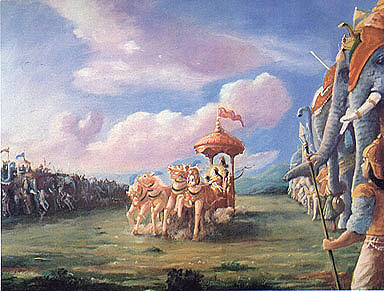
The warriors of both the sides met and settled the rules
of the war. Only equals will fight in personal duels. Those who surrender,
there lives will be spared, No charioteer, animal, or servants who were
not soldiers were to be attacked. These and some other rules that were
usual in a Dharma-Yuddha or a righteous war were finalised and both the
sides agreed to abide by them.

On the eve of the war, sage Vyasa visited the palace of
Dhritarastra, who was his son, now the terrible days are in store. All
your sons and the kings will be killed soon. This is settled by fate. It
is ordained so, do not be sorry. I shall grant you your eyesight so that
you may witness the war. Dhritarastra was shaken by the stark words of
the sage. He said, ‘My lord, I have been blind all my life. I do not want
to see my sons dying in the battlefield. If someone can give me an account
of the war as it unfolds, I shall be happy. Vyasa said, Sanjaya would get
the power to see everything that happens in the war. He will be able to
see during the day as well as in the night. He shall be even able to know
the thoughts of the persons engaged in the war. He shall not be tired or
exhausted. The omens are all against the Kauravas." Saying this the great
sage departed.
(After this the entire account of the war is as related
by Sanjaya to the blind king Dhritarastra)
Duryodhana was busy arranging his troops in a battle array.
He told Dussashan, ‘take care to protect our grandsire, Bhishma. All the
chariots and warriors should be placed in such a position to Bhishma. He
alone is capable of destroying the entire army of the Pandavas led by Dhristadhyumna.
We should pay special attentions to kill Shikhandi. He could be a source
of danger to Bhishma.
Then (one Akshauhini of Army comprises of 21870 chariots,
21870 elephants, 65610 horses and 109350 men.) akshauhinis of the Kauravas
army was arranged in Vyuha (battle array) and one akshauhini was under
the direct control of Bhishma. Bhishma chariot was white-silver coloured,
it was driven by white horses and his flag was golden, bearing his personal
insignia. The Sun was rising in a golden dawn. Bhishma spoke to his soldiers,
"Today is a very auspicious day. The gates of heavens are open to all the
Kshatriyas who will be fortunate to die in the battle. It is not beckoning
of a Kshatriya to die in bed or of sickness. Battlefield is the only glorious
place to die. Without thinking about tomorrow do your best to win the war.
Karna was the only warrior who had not joined the war. Bhishma chief body
guard was Ashwathama, who was supported by seven more warriors. Salya and
Bhurishrava were among them. Duryodhana’s banner was proudly fixed a top
his chariot.
Looking at the vast army of the Kauravas, Yudhisthira
said to Arjuna. Their army is so huge. They have eleven akshauhinis against
them we have only seven. How best can be arrange our army in battle formation.
Bhishma is quite formidable. Arjuna said, that he would arrange the army
in a ‘Vyuha’ named ‘Vajra’. This was the favourite arrangement of lord
Indra. Dhristadhyumna was in the centre of the army. Bhima, Yudhisthira,
protected him and Arjuna supported Shikhandi. The most prominent banner
in the Pandava side was that of Arjuna, having lord Hanumana himself on
it, driven by Krishna, having white horses. All those who knew the reality,
saluted Krishna. Krishna said to Arjuna, ‘See the army of the Kauravas,
led by your old grandsire. The lion among the Kaurava heroes, is your first
victim.
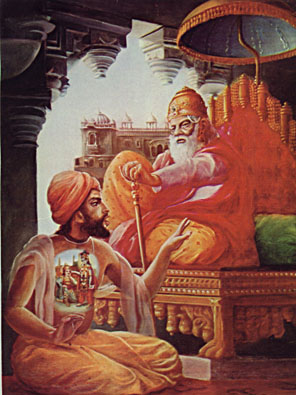

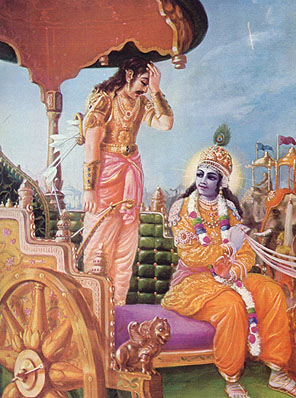

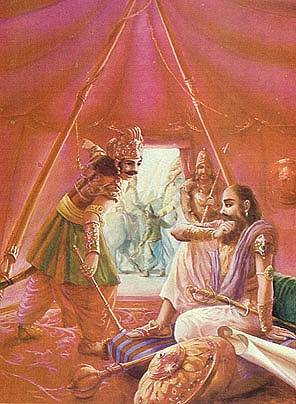
courtesy BBT Int.

This is the anniversary day commemorating
the day that Srimad Bhagavad Gita was spoken by Lord Sri Krishna to His
dearmost devotee Arjuna at the place now known as Jyotisar Tirtha amid
the waring families of the Kurus and the Pandavas at Kurukshetra. If one
wishes one can still go and visit that place and see the monument erected
there with Krishna as Parthasarati (the chariot driver) and Arjuna the
warrior on their chariot. It is claimed by the ashram who maintain the
shrine that the tree that is next to Them is a continum growth of the original
tree witness that was there at the actual day of speaking.
Traditionally devotees come to Kurukshetra (Dharmakshetra)
and recite Bhagavad Gita from early morning until the next morning, perform
arati to Bhagavad Gita and to Krishna and Arjuna upon the chariot, offer
lamps 'deep daan' at Brahma Sarovar, shloka recitals, shobha yatras and
seminars on the significance of the Gita today.
Devotees who cannot get to Jyotisar Tirtha remember the
blessed event by reciting Bhagavad Gita, performing Bhagavad Gita ahuti
of each verse or selected chapters into the sacred fire, and discussing
the subject matter of Bhagavad Gita in the association of devotees. Distribution
of Bhagavad Gitas' on this day is also a very auspicious activity to perform.
What is the Bhagavad Gita?
The Bhagavad Gita(BG) was spoken by Sri Krishna to His
friend and disciple, Arjuna at the beginning of the epic war, Mahabharata.
BG provides the concise conclusion of the millions of verses in all the
Vedic scriptures. In just eighteen chapters containing seven hundred verse,
Sri Krishna answers all questions about the duty of the living entity.
In glorifying the BG, Lord Shiva says in the Gita Mahatmya (Padma Purana)
that it is sufficient to lead one to liberation.
How should one read the BG?
The BG should be studied in the same mood as it was heard
by Arjuna. Sri Krishna declares that He is revealing this most confidential
knowledge to Arjuna because is not envious and He is a friend. So one must
read and understand the BG in the mood of at least theoretically accepting
the position of Krishna as God. This knowledge is never revealed to one
who reads it in a challenging and speculative mood.
Owing to the universal message in the BG, many people
take to it instinctively. Unfortunately its importance has also given rise
to many people speculating and misinterpreting it. In order to protect
the trusting people from this kind of cheating, Sri Krishna stresses the
importance of Paramapara (disciplic succession) and Guru (spiritual master)
in receiving the knowledge of the BG.
Who should read the BG?
The BG is often referred to as the "Handbook for humanity".
Never in the BG has Sri Krishna restricted the scope of the BG to Hindus
or Indians. It is completely non-denominational, meant for any one inquiring
about his reason for existence. Indeed many people following Christianity
or Islam get a much better perspective of their own religion after reading
the BG and are able t o follow their religions with greater conviction.
What is Purpose of the BG?
The BG was spoken to guide the conditioned soul on the
path of the spiritual advancement. It is presented as principle and details.
The dominating principle of the BG is to develop God consciousness. In
the details, Sri Krishna explains three primary ways of doing this and
then further expands on these paths. He then relates them to each other
and brings forth the single most effective path for returning back to God
What are the three paths?
These paths are explained as yoga. The Sanskrit word
"yoga" means connecting to the absolute, and it is in this context that
the word yoga is used in the BG.
The three paths given by Sri Krishna are Karma yoga, Jnana
yoga and Bhakti yoga. The first six chapters primarily discuss Karma yoga,
liberation by performing prescribed activities. The last six chapters primarily
talk about Jnana yoga, liberation by worshipping the Lord through one's
intelligence. Ensconced between these two "protective" covers, like a pearl
in the oyster, in the middle six chapters, Krishna reveals the most confidential
of all knowledge, Bhakti yoga, the path of pure, unalloyed devotional service.
He declares this to be the highest, the easiest and the fastest path to
Him, and for one who is fortunate to embark on it, the binding illusions
of Maya are dispelled in no time.
What is Karma yoga?
A person situated in Karma yoga executes one's prescribed
duties. These duties are as prescribed by the Varnashrama system created
By Krishna through the Vedas. According to one's ability and inclination,
a person may acquires a particular varna. He may become a Brahaman (teacher,
guide), Ksatriya (administrator, warrior), Vaishya (merchant, farmer) or
Sudra (worker). According to his situation he lives in one of the four
ashrams: Brahamacari (student), Grahastha (married), Vanaprastha (retired)
and Sannyasa (detached). The eight fold Varnashram system is created to
allow one to be aware of his prescribed duties and execute them properly.
It is important to note here is that the BG stresses that a varna is acquired
by one's ability and inclination, never by birth. So in the BG, there is
no support of the "caste-system" prevalent in India. The Varnashram system
appears naturally in all societies over the world.
Performing prescribed duties will earn a person much pious
credit, but it will also continue to bind him to the material world. So
Karma can be "sakarma" (done in anticipation of enjoying its fruits) or
"nishkarma" (detached from the results). In both cases a person is attached
to performing the activity. However, when a person performs activities
only for the pleasure of the Lord, he has reached the stage of Bhakti.
For instance Sadhna (japa, arati, kirtan) are activities performed with
no material motives, simply to glorify or remember the Lord. Thus Karma
yoga can be used to elevate one self to the position of Bhakti yoga by
first performing prescribed activities, then renouncing the fruits of the
activities to Krishna and finally by renouncing the activity in itself
to Krishna.
What is Bhakti yoga?
The path of devotion is described as the most confidential
path back to Godhead. It is described as the "elevator" approach to Krishna
as opposed to all the other "staircase" paths. The essence of the Bhakti
yoga is summarized by Sri Krishna in Chapter 9, Verse 34, as follows: "Engage
your mind always in thinking of Me, become My devotee, offer obeisances
to Me and worship Me. Being completely absorbed in Me, surely you will
come to Me."
This verse, often considered to be the summary verse of
the entire BG, contains the essence of the existence of a spirit soul.
In the material world, trapped in the illusory sense of identifying with
the body and its extensions, a spirit soul remains forever bewildered by
the duality of existence. However by simply surrendering to Krishna, understanding
Him to be the original, primeval cause of all causes and thus worshipping
Him without any desires of material benefit, one can easily go back to
Him.
Bhakti yoga does not mean inactivity. Indeed a bhakta
is most active, for he sees all his activities now in relation to the Supreme.
But he is detached from the activity and the fruits of the activity, neither
happy in success nor distressed in failure, understanding that all this
is ultimately for Krishna and coming from Him only.
What is Jnana yoga?
In the Jnana section Krishna elaborates about the five
factors of existence: Isavara (God), Jivatma (Soul), Kala (Time), Karma
(actions) and Prakriti (Nature). He explains that while Kala, Prakriti,
Jiva and Isavara are eternal, Karama is not. As long as one is involved
in fruitive activities, the cycle of Karma, performed in one of the three
modes of material Nature (goodness, passion, ignorance) is binding. For
every action, good or bad, there is a reaction. This cycle can only be
broken by performing devotional service, since that does not have any reactions,
good or bad. In this stage the person transcends the material plane of
existence and enters into the spiritual realm.
When Krishna explains the path of spiritual advancement
by knowledge, Arjuna gets confused between the Karma (action) and Jnana
(inaction). Krishna explains that one must strive for activities performed
in knowledge of Him, which will ultimately lead to Bhakti. Philosophy without
faith is speculation, and faith without philosophy is rituals. The two
must complement each other. Thus, Krishna once again stresses that the
ultimate goal of all transcendentalists is Him. They may reach Him directly
by Bhakti or first reach Bhakti through Karma or Jnana.
Why has Krishna given alternatives?
A confusing aspect of the BG is the fact that while acknowledging
the superiority of Bhakti yoga. Krishna spends considerable time talking
about Jnana and Karma yoga. He even speaks briefly about the eight fold
astanga yoga process followed by the mystics. For many people this is very
confusing if not apparently contradictory.
In reality. Krishna is offering some thing for every one
according to their levels of advancement and inclination. As God, He does
not interfere with the free will of a living entity. But as the most compassionate
well wisher He wants every one to leave this material world of misery and
return to the original spiritual abode.
So, for a person attracted to action, there is Karma yoga.
For the intellectual there is Jnana yoga. For the mystic there is astanga
yoga. The BG meets the person at the level they are in and gradually
elevates them to the platform where they become qualified to execute Bhakti
yoga, pure devotional service. A very few fortunate souls, by the causeless
mercy of Krishna and His devotees, are able to take directly to Bhakti,
and for them the way back to Godhead is quick and easy.
Conclusion
We hope that these points address your interests and
motivate you to read the Bhagavad Gita As It Is.
Read Bhagavad Gita On-line HERE: http://www.asitis.com/

Bhagavad Gita Pictures - Copyright ©2005 The Bhaktivedanta Book
Trust
International, on the web at http://www.krishna.com.
Used with permission.

The following Sections are from Sri Gaudiya Kantahara
In Satya-Yuga, There was Only
one Varëa Paramahaàsa
14.19
ädau kåta-yuge varëo
nåëäà haàsa iti småtaù
kåta-kåtyäù
prajä jätyä tasmät kåta-yugaà viduù
In the beginning, Satya-yuga,
there was only one social class, called "haàsa". In that age everyone
was perfect (in devotional service) from birth. That age is therefore known
as Këta-yuga, or the age in which all religious duties are fulfilled.
(Bhäg. 11.17.10)
14.20
tretä-mukhe mahä-bhäga
präëän me hådayät
trayé
vidyä prädurabhüt
tasyä
aham äsaà tri-vån
makhaù
O blessed Uddhava, at the beginning
of the Treta-yuga the threefold Vedas was manifest from My heart thorough
My breath; and through the threefold Vedas I (who am known a Yajïa)
appear as sacrifice. (Bhäg. 11.17.12)
14.21
vipra-kñatriya-viö-çüdrä
mukha-bähüru-päda-jäù
vairäjät puruñäj
jätä ya ätmäcära-lakñaëäù
The four social orders appeared
from the universal form of the Lord. The brähmaëas appeared from
His face, the kñatriyas from His arms, the vaiçyas from His
thighs, and the çüdras from His feet. Each social order is
characterized by specific systems and behavior. (Bhäg. 11.17.13)
Previously, Everyone was a Brähmaëa.
Later, According to Guåa
and Karma, Different Divisions Arose
14.22
na viçeño' sti varëänäà
sarvaà brähmam-idaà jagat
brahmaëä pürva-såñöam
hi karmabhir-varëatäà gatam
[Båghu Muni said] Previously
there was only one varëa. Because everyone was born of Brahmä,
everyone was a brähmaëa. However, later on different castes were
categorized according to their activities. (Mahäbhärata, Çänti
Parva 188.10)
The Position of Varëa-Dharma
in Kali-yuga
14.23-27
brähmaëäù
kñatriyä vaiçäù çüdräù
päpa-paräyaëäù
nijacärä-vihénäç
ca bhaviñyanti kalau yuge
viprä veda-vihénäç
ca pratigraha-paräyaëaù
atyanta-käminaù krürä
bhaviñyanti kalau yuge
veda-nindäkaräç
caiva dyütacaurya karäs tathä
vidhavä-saìga-lubdhäç
ca bhaviçanti kalau dvijäù
våtty-arthaà brähmaëäù
kecit mahäkapaöa-dharmiëaù
raktämbarä bhaviñyanti
jaöiläù çmaçrudhäriëaù
kalau yuge bhaviñanti brähmaëäù
çüdra-dharmiëa
In Kali-yuga, all four varëas
are devoid of character and proper behavior and are addicted to sin. The
brähmaëas are devoid of Vedic knowledge and sacrifice. Giving
up the five sacrifices recommended in the Vedas and all brahminical behavior
and consciousness, they engage in inferior activities. They collect charity
to satisfy their unlimited appetite for sense enjoyment. The brähmaëas
of Kali-yuga are characterized by the qualities of lust and cruelty. Unholy
in deed and thought, they take pleasure in envy and malice. These professional
thieves blaspheme the Vedas, drink liquor, and exploit women for sex, taking
great pleasure in adultery and fornication. They accept extremely sinful
means of maintaining their lives and, posing as svämés, dress
in red cloth and wear long hair and beards. In this way the wretched so
called brähmaëas of Kali-yuga accept the dharma of çüdras,
that is, they become fourth-class men. (Padma Puräëa)
Brähmaëas in Kali-yuga
are Brähmaëas in Name only
14.28
räkñasäù
kalim-äçritya jäyante brahma-yoniñu
utpannä brähmaëa-kule
bädhante çrotriyän kåçän
Those who were räkñasas
in previous ages, have taken birth as brähmaëas in Kali-yuga
to torment the physically weak saintly persons who are engaged in the culture
of hearing about the Lord. (Cb. Ädi 11.298)
The Evidence from Caitanya-Bhägavata
14.29
ei sakala räkñasa "brähmaëa"
näma mätra
ei saba loka yama-yätanära
pätra
kaliyuge räkñasa-sakala
vipra-ghare
janmiveka sujanera hiàsä
kariväre
e-saba viprera sparça, kathä
namaskära
dharma-çästre sarvathä
niñedha kariväre
All these demons are "brähmaëas"
in name only. All of them will be finished by the agents of the king of
death, Yamaräja. In Kali-yuga, demons take birth in the houses of
brähmaëas to harass saintly persons. All the dharma-çästras
forbid one to touch, hear from or offer obeisances to such materialistic
and demoniac brähmaëas. (Cb. Ädi 11.293-295)
The småti on how the Brähmaëa
Caste was Debased
14.30 and 31
jatiratra mahä-sarpa manuçyatve
mahä-mate
saokarät sarva-varëänäà
duñparékñyeti me matiù
sarve sarväsva patyäni
janayanti sadä naräù
väìghaithunamatho janma
maraëaï ca saman nåëäm
[Yudhiñöhira told
Nahüña] O noble-minded and great serpent, it is very difficult
to ascertain one's caste because of promiscuity among the four orders.
This is my opinion. Men belonging to all castes beget offspring among women
of all the different castes. And among men of different caste the speech,
sexual intercourse, birth, and death have become are common to all. (Mahäbhärata,
Vana Parva 180.31-32)
The Opinion of the Truth-Loving
Vedic ëïis
14.32
'na caitad-vidmo brähmaëaù
smo vayam abrähmaëa veti'
"We don't know whether we were
brähmaëas or non-brähmaëas. (Mahäbhärata,
Vana Parva 179.33)
The Çruti, Småti,
Puräëas, and Itihäsas
on the Occupational Duties
of Brähmaëas
14.33
Brahma-kñatriya-vaiçya-çüdro
iti catväro varëäs teñäà varëänäà
brähmaëa eva pradhäna iti veda-vacanänu-rüpaà
småtibhir apy uktam. Tatra codyam asti ko vä brähmaëo
näma. Kià jévaù kià dehaù kià
jätiù kià jïänaà kià karma kià
dhärmika iti. Tatra prathmo jévo brähmaëa iti cettana,
atétänägatän eka dehänäà jévasyaika-rüpatvät
ekasyäpi karma-vaçädan-eka-deha sambhavät sarva çaréräëäà
jévasyaika-rüpatväcca. Tasmän na jévo brähmaëa
iti. Tarhi deho brähmaëa iti cettnna, äcäëòälädi-paryantänäà
manuñyäëäà päïca-bhautikatvena.
Dehasyaika-rüpatväj-jarä-maraëa dharmädharmädi
sämya-darçanäd brähmaëaù çvetavarëaù
kñatriyo rakta-varëo vaiçyaù péta-varëaù
çüdraù kåñëa-varëa iti niyamäbhävät.
Piträdi-çaréra dahane puträdénäà
brahma-hatyädi-doña-sambhaväcca tasmän na deho brähmaëa
iti. Tarhi jäti brähmaëa iti cenna. tatra jätyantarajantuñu
aneka-jäti-saàbhavä maharñayo bahavaù santi.
Eñya-çåogo mågyäù kauçikaù
kuçät jämbüko jambükät.Välméko
valmékät. Vyäsaù kaivartta-kanyäyäm.
Çaçapåñöhät gautama. Vasiñöhaù
urvaçyäm. Agastyaù kalase jäta iti çrutatvät.
Eteñäà jätyä vinäpyagre jïäna-prati-päditä
åñyo bahavaù santi. Tasmän na jätiù
brähmaëa iti. Tarhi jïänaà brähmaëa
iti cettnna. Kñatriyädayo'pi paramärtha-darçino'bhijïä
bahavaù santi. Tasmänha jïänaà brähmaëa
iti. Tarhi karma brähmaëah iti cettanna. Sarveñäà
präëinäà prärabdha-saïcitägämi
karma-sä dharmya-darçanät karmäbhipreritäù
sant janäù kriyäù kurvanéti. Tasmän
na karma brähmaëa iti. Tarhi dhärmiko brähmaëa
iti cettnna. Kñatriyädayo hiraëyadätäro bahavaù
santi. Tasmänna dhärmiko brähmaëa iti. Tarhi ko vä
brähmaëo näma. Yaù kaçcid-ätmänam-advitéyaà-jäti-guëa-kriyähénam
ñaòürmiñaò-bhävetyädi-sarva-doña-rahitaà
satya-jïänänandänta-svarüpaà svayaà
nirvikalpaà açeña-kalpädhäraà açeñabhutähtaryämitvena
vartamänaà antarbahiç-cäkäçavadanu-syütama-khaëòänanda-svabhävam-aprameya
manu bha vai kavedya parokñatayä bäsamänaà
karatalämalakavat säkñäd-aparokñé-kåtya
kåtärthatayä käma-rägädi-doña-rahitaù
çama damädi-sampanno cetä vartata, eva mukta-lakñaëo
yaù sa eva brähmaëa iti çruti-småti-puräëetihäsänäm-abhipräyaù.
Anyathä hi brähmaëtva-siddhir nästy eva.
The four varëas are: brähmaëa,
kñatriya, vaiçya, and çüdra. Among these, the
brähmaëas are foremost. This is the verdict of the Vedas and
the Småti. In these places the question is asked, "Who is a brähmaëa?
On what basis is someone a brähmaëa? Among life (jéva),
body (deha), birth (jäti), knowledge (jïäna), work (karma),
and duty (dharma) what is it that constitutes a brähmaëa?"
The first question is: Since
the jéva is part of Brahman, and alive, does that make him a brähmaëa?
No. It is incorrect to call any jéva a brähmaëa. There
are countless jévas who have accepted innumerable material bodies
according to their karma and mentality, but they cannot all be called brähmaëas).
The next point is whether
one's body (deha) makes one a brähmaëa. The answer is no. The
body of a caëòäla as well as that of all other men are
subject to infirmity and death. It is only with respect to the way in which
the mentalities of different classes of men are colored by different conceptions
of religion and irreligion that brähmaëas are called "white,"
(ïveta-varëa) kñatriyas "red," (rakta-varëa) vaiçyas
"yellow," (péta-varëa) and çüdra "black" (kåñëa
varëa). In this way, it should be clearly understood that one is not
a brähmaëa on the basis of his body (deha). By burning up one's
body one does not become free from the sin of killing a brähmaëa;
nor is that sin transferred to one's son. In the same way one's brahminical
status is not based on one's bodily condition, nor can brahminical status
be transferred simply by seminal discharge and the procreation of children.
Therefore it is concluded that the body (deha) does not make one a brähmaëa.
The next point is whether
one becomes a brähmaëa by birth (jäti). The answer is no.
In the midst of mixed ancestry have come great-souled åñés.
The åñé Çëåga took birth from a deer,
and Kauçika was born from straw, Jämbùka åñé
was raised by a jackal, and Välmiké came from an anthill. Vyäsa
was born from a fisherman's daughter and the sage Gautama was born from
a rabbit. Vaçiñtha was born from a dancing girl Urvaçé.
From a pitcher (in which semen was stored) the sage Agastya took birth.
There are many examples of great saints who did not know in what circumstances
they took birth. Therefore birth does not make a brähmaëa.
And what of jïäna?
Knowledge does not make a brähmaëa either. Many kñatriyas
are vastly experienced in knowing the supreme goal of life. Therefore knowledge
does not make a brähmaëa.
What about fate? Karma does
not make one a brähmaëa either. All living beings have amassed
karma from previous lives and have their karmic destinies to live out in
the future along with their karmas and dharmas. According to one's karmic
desires he is further implicated in karmic fate and continues to live in
the world of action and reaction. A "brähmaëa" is more than this,
and therefore karma does not make one a brähmaëa.
Then what about dharma, religion?
Mundane piety does not make a brähmaëa either. There are many
examples of great kñatriyas who were highly religious and gave much
gold in charity, but they were not brähmaëas.
Then what is a brähmaëa?
A brähmaëa is one who is absorbed only in the Supreme Self. He
is free from all mundane attributes of birth, work, and materialistic qualities,
who is free from all faults. His very nature is that he takes pleasure
in the knowledge of the limitless Supreme Truth. A real brähmaëa
is completely absorbed in the infinite, limitless, absolute Supreme Person
(present within the heart of every living being as the Supersoul just as
ether pervades everything). That Supreme Lord is indivisible, and His very
nature is divine ecstasy. The infinite is not a mango that can be grasped
through sense experience; neither can He be known, directly or indirectly,
through mental speculation.) Such a brähmaëa is free from faults
such as lust, anger, greed, pride, illusion, and envy. He has all twelve
brahminical qualities beginning with peacefulness and self-control (çamo,
dama, tapa, etc.). He is never envious and is free from illusion and from
any touch of pride and false ego. One who has these qualities may be called
a brähmaëa. This is the opinion of the Çruti, Småti,
Puräëas and Itihäsas. No other endowments of perfection
can confer brahminical status. (Vajra-sücikä Upaniñad)
Evidence from the Mahäbhärata
14.34
çüdre caitad-bhavel-lakñma
dvije tac ca na vidyate
na vai çüdro bhavec-chudro
brähmaëo na ca brähmaëoù
If it is seen that a çüdra
has the characteristics of a brähmaëa he should be considered
a brähmaëa. Similarly, if a brähmaëa has the characteristics
of a çüdra he should be considered a çüdra. (Mahäbhärata,
Vana Purva 180.25)
Evidence From Çrémad-Bhägavatam
14.35
yasya yal lakñaëaà
proktaà puàso varëäbhivyaïjakam
yad anyaträpi dåçyeta
tat tenaiva vinirdiçet
If one shows the symptoms of
being a brähmaëa, kñatriya, vaiçya, or çudra,
as described above, even if he has appeared in a different caste, he should
be accepted according to those symptoms of classification. (Bhäg.
7.11.35)
The Ancient commentator, Nélakaëöha,
on the Conduct of Brähmaëas
14.36
evaïca satyädikaà
yadi çüdro'pyasti tarhiso'pi brähmaëa eva syät
çüdra lakñmakädikaà na brähmaëo'sti
näpi brähmaëa-
lakñmaçamädikaà
çüdro'sti.
çüdro'pi çamädyupeto
brähmaëa eva, brähmaëo'pi
kämädyupetaù çüdra
eva
In the same way if a çüdra
has qualities like truthfulness then he is a brähmaëa.
And if a brähmaëa does
not show the qualities such as peaceful nature which are appropriate for
a brähmaëa, then he is a çüdra. If a çüdra
has qualities like equananimity then he is a brähmaëa. If a brähmaëa
has qualities like lust then he is a çüdra. (Nélakaëöha
commentary on Mahäbhärata, Vana Parva 180.23-26)
Çrédhara Svämé's
Opinion
14.37
çamädibhireva brähmaëädi
vyavahäro mukhyaù na jätimäträt.
yad yadi anyatra varëäntare'pi
dåçyeta, tad-varëästaraà
tenaive lakñmaëa-nimittenaivavarëena
vinirdiçet, na tu jätinimitenetyarthaù
The qualities of a brähmaëa,
beginning with peacefulness (çamo, dama, tapaü, etc.) represent
the chief characteristics or principle behavior of a brähmaëa.
On the other hand, birth is no qualification for brahminical status. If
one is seen to take birth in another varëa, but has the qualifications
of a brähmaëa, his birth should be disregarded and he should
be accepted as a brähmaëa. One who is born a brähmaëa
may be accepted as a brähmaëa if he has the qualifications, but
otherwise he should not. (Bhävärtha-dépikä commentary
on Çrémad Bhägavatam 7.11.35)
Mahäprabhu's Definition of
What is and Isn't a Brähmaëa
14.38
sahaje nirmala ei 'brähmaëa'-hådaya
kåñëera vasite
ei yogya-sthäna haya
'mätsarya'-caëòäla
kene ihän vasäile
parama pavitra sthäna apavitra
kaile
The heart of a brähmaëa
is by nature very clean; therefore it is a proper place for Kåñëa
to sit. Why have you allowed envy to sit there? Because of this , you have
become like a caëòäla, the lowest of men, and you have
also contaminated a most purified place your heart. (Cc. Madhya 15.274-275)
The Evidence of the Småti
14.39
etan me saàçayaà
deva vada bhütapate'nagha
trayo varëäù prakåtyeha
kathaà brähmaëyamäpnuyuù
sthito brähmaëa-dharmeëa
brähmaëyam-upajévati
kñatriyo vätha vaiçyo
vä brahma-bhüyaà sa gacchati
[Umä said] "O Çiva,
master of the bhütas. O sinless one, through what kind of personal
characteristics can the three classes of men kñatriya, vaiçya,
and çüdra become brähmaëas? Is it possible for them
to become brähmaëas? Please enlighten my doubts on this subject."
Çiva said, "If a kñatriya or vaiçya is established
in brahminical behavior, and spends his whole life in brahminical conduct,
it is seen that such a person has attained brahminical status. (Mahäbhärata,
Anuçäsana Parva 14.3.5,8)
The Verdict of the Mahäbhärata
on the Occupation of Brämaåas
14.40 and 41
sämprataïca mato me'si
brähmaëo nätra saàçayaù
brähmaëaù patanéyeñu
vartamäno vikarmasu
yastu çüdro dame satye
dharme ca satatothitah
taà brähmaëam ahaà
manye våttena hi bhaved-dvijaù
(The brähmaëa told
the "hunter"), "In my opinion, you are a brähmaëa. Of this there
is no doubt. It is my consideration that the brähmaëa who is
proud and addicted to sin, who is full of vice and always engaged in evil
and degraded practices, is certainly a çüdra. On the other
hand, a çüdra who is endowed with the virtues of righteousness,
self-restraint, and truthfulness is, in my opinion, a brähmaëa.
The only qualifications for brahminical status are truthful character and
saintly behavior. (Mahäbhärata, Vana Parva 215.13-15)
14.42 and 43
hiàsänåta-priyä
lubdhäù sarva-karmopjévinaù
kåñëa çaucaparibhrañöhäste
dvijäù çüdratäà gatäù
sarva-bhakñyaratirnityaà
sarva-karmakaro 'çuciù
tyakta-vedastvanäcäraù
sa vai çüdra iti småtaù
Brähmaëas who live
a life of violence, lies, and greed, who are impure and indulge in all
kinds of karmic activity in order to maintain their lives are degraded
to the status of çüdras. Such a person, who eats anything and
everything without discrimination, who is attached to worldly things, who
will accept any occupation just to make money, who has given up Vedic dharma
and proper behaviour is called a çüdra. (Mahäbharata,
Çänti Parva 189.7)
The Småti on the Occupational
Behavior of Brähmaëas
14.44
yatraital-lakñyate sarpa
våttaà sa brähmaëaù småtaù
yatraitan na bhavet sarpa taà
çüdramili nirdiçet
[Yudhiñöhira said]
"O serpent, whoever has the characteristics of a brähmaëa is
said to be a brähmaëa. One who doesn't have the characteristics
of a brähmaëa is a çüdra, even if he is "born" a
brähmaëa. (Mahäbharata, Vana Parva 180.26)
An Example of the Conduct of a Brähmaëa
14.45
taà hoväca kià
gotro nu saumyaséti.
Sa hoväca nähametadveda
bho yad-gotro 'ham asmi.
Apåcchaà mätaram
sä mä pratyabravéd
bhahvahaà caranté
paricäriëé yauvane tvämalabhe.
Sähaà etat na veda yad-gotras-tvamasi.
Jabälä tu nämä
ahamasmi, Satyakämo näma tvamaséti.
So'haà satyakämo Jäbälo
'smi bho iti.
Taà hoväca naitadabrähmaëo
vivaktum-arhati samidhaà
saumyä ähara. Upa tvä
nesye. Na satyädagä iti.
Gautama asked Satyakäma,
"My dear boy, what is your gotra?" The boy said, "I do not know what my
caste or family background is. I asked my mother, and she said, 'When I
was young, I wandered here and there and knew many men. Then you were born.
I knew so many men that I don't know who your father is, or what your caste
is. All I know is that my name is Jabàla and your name is Satyakäma
(One who wants truth).' Therefore I am known as the Satyakäma of Jabàla,
and do not know my caste".
Gautama said, "My dear boy,
you speak truthfully, and therefore you must be a brähmaëa. No
one but a brähmaëa could speak such an unpalatable truth. O beautiful
young boy, go and bring me wood for the sacrificial fire. I shall initiate
you as my disciple, for you never depart from the truth. (Chändogya
Upaniñad 4.4.4, Gautama)
14.46
ärjvavaà brähmaëe
säkñät çüdro'närjava-lakñaëäù
gautamastv iti vijïäya
satya-kämamupänayat
Truthfulness is the symptom
of a brähmaëa, whereas dishonesty is the sysmptom of a çüdra.
Knowing this, Gautama Åñé initiated Satyakäma
as a brähmaëa. (Chändogya Upaniñad, Mädhva-bhäïya,
Sàma-saàhitä)
The Evidence of Vedänta-sütra
and the Example of Citraratha
14.47
"çugasya tadanädara-çravaëät
sücyate hi"
näsau pauträyaëaù
çüdraù çucäd-bravaëam eva hi çuda
tvam
räjä pauträyaëaù
çokäc-chudroti muninoditaù präëa-vidyäm-aväpyäsmät
paraà dharma-väptavän
The following story is from
the Chandogya Upaniñad (Saävarga-vidya 4): There was a great
king named Jänaçruti Pauträyaåa, who was famous
for his good works. Two ëïis wanted to create a desire for spiritual
knowledge in his heart and they took the form of swans to accomplish this.
One of them praised the king while the other contemptously accused him
of lacking spiritual knowledge. The swan then praised the sage Raikva for
being very learned. Upon hearing this the king was smitten with grief and
approached the sage Raikva with presents seeking spiritual knowledge from
him. Raikva twice addressed the king çüdra. "O Çüdra,
you have brought all these presents, and now you want me to instruct you?"
Thereafter, Raikva taught him the spiritual science.
The Brahma-sütra says:
"Raikva addressed Jänaçruti Pauträyana as çüdra
because Pauträyana was overwhelmed with sorrow." The use of the word
çüdra in this verse does not mean that Jänaçruti
was a çüdra at birth, but that he was lamenting. The purport
is that those who are overwhelmed by lamentation are known as çüdras.
It is written in the Padma-Puräëa that King Pauträyana was
a kñatriya and that because of his lamentation, Raikva Muni called
him a çüdra. [The word çüdra, therefore, means
"one who laments."] Later, Pauträyana gained knowledge of the ultimate
goal of life and the supreme religion from Raikva. (Brahma-sütra 1.3.34)
Madhväcärya's Commentary,
Quoting from Padma-Puräëa
14.48
"kñatriyatvävagateç
ca uttaratra caitra-rathena liogät" bhäñye:
"ayaà açvatarératha
iti citraratha samvandhinitvena liogena pauträyaëasya kñatriyatvävagateç
ca rathastvaçvataréyuktaçcitra
ityabhidhéyate iti brähme
yatra vedo rathas tatra na vedo yatra no ratha iti ca brahma-vaivarte"
The Brahma-sütra says:
"That Jänaçrüti was kñatriya and not a çüdra
is understood from the rest of the story, where he is described along with
a kñatriya, Abhipratàrin, who was a Caitra-ratha." [Because
Jänaçrüti was a kñatriya and not a çüdra
by quality, he was fit for hearing spiritual knowledge from Raikva Muni,
who would not have instructed him if he actuallly was a çüdra.
The purpose of Raikva Muni's calling him a çüdra was simply
to illustrate that constant lamentation is the quality of a çüdra,
and that if he were to instruct Jänaçrüti, the king would
have to rid himself of the tendency toward lamentation. That Raikva did
instruct Jänaçrüti is proof that the king freed himself
from the tendency, and was not a çüdra, but was qualified to
study the Vedas. Those who have the qualities of çüdras are
forbidden to study the Vedas because they will pervert the meaning of the
Vedas.] The whole point is that one may know a person's varëa from
his qualities. (Brahma-sütra 1.3.35 and commentary)
Members of Other Castes who Became
Brähmaëas
14.49
näbhägä-diñöaputro
dvau vaiçyau brähmaëatäà gatau
Näbhäga and Diñöhaputra
were two vaiçyas who attained the status of brähmaëas.
(Hari-vaäça 11)
14.50-56
evaà vipratvamagamadvétahavyo
narädhipaù
bhågoù prasädäd
räjendra kñatriyaù kñatriyarñabha
tasya gåtsamadaù putro
rüpeëendra iväparaù
sa brahmacäré virprarçiù
çrémän gåtsamado 'bhavaà
putro gåtsamadasyäpi
sucetäbhavat-dvijaù
varcäù sutejasaù
putro vihavyastasya cätmajaù
vihavasya tu putrastu vita-tasya
cätmajaù
vitatasya sutaù satyaù
santaù satyas sya cätmajaù
çravästasya sutaçcarñiù
çravasaçcäbhavattamaù
tamasaç ca prakäço
'bhuttanayo dvijasattamaù
prakäçasya ca vägindro
babhuva jayatäà baraù
tasyätmajaç ca pramitirveda-vedäìgapäranga
ghåtäcyäà
tasya putrastu rururnämodapadyata
pramadvaräyasta ruroù
putraù samupadyata
çunako näma viprarñiryasya
putro'tha çaunakaù
[Bhéïma] explained
how King Vétahavya became a brähmaëa: "O King Rajendra,
best of the kñatriyas, Vétahavya was a kñatriya, but
by the grace of Bhågu Muni, he became a brähmaëa. His son,
Gëtsamada, who was inferior to none save Indra, was a brahmacäré
and a learned Åñé. Gëtsamada's son, Suceta, was
a learned brähmaëa. Suceta's son was Varcäh, and his son
was Vitatya, whose son was Vägindra. His son was Santa, his son was
ëïiçravä, his son was Tama. Tama's son, was the best
of brähmaëas, Prakäça, whose son was Vägindra,
the foremost of all reciters of the Vedic mantras. Vägindra had a
son whose name was Pramati. Pramati was a master of all the Vedas and their
branches. Pramati begot in the womb of the apsarä, Ghëtàcé,
a son named Ruru, who had a son by his wife, Pramadvara. Ruru's son was
the venerable åñé, Çunaka. The son of Çunaka
was the great sage Çaunaka (who heard Bhägavatam from Suta
Gosvämé at Naimiçaraåya).
In this way, O best of kings,
the great king Vétahavya, a kñatriya, attained the status
of a brähmaëa by the mercy of Bhrgu, and by dint of his sons
and decendants becoming great brähmaëas. (Mahäbhärata,
Anuçäsana, 30.66, 58, 60-65)
Examples from Bhägavatam
on Brahminical Conduct
14.57
yavéyäàsa ekäçétir
jäyanteyäù pitur ädeçakarä mahä-çälénä
mahä-çrotriyä yajïa-çéläù
karma-viçuddhä brähmaëä babhüvuù
In addition to these nineteen
sons mentioned above, there were eighty-one younger ones, all born of Rñabhadeva
and Jayanté. According to the order of their father, they became
cultured, well-behaved, pure in their activities, expert in Vedic knowledge
and the performance of Vedic rituals. (Bhäg. 5.4.13)
14.58
püror vaàçaà
pravakñyämi yatra jäto 'si bhärata
yatra räjarñayo vaàçyä
brahma-vaàçyäç ca jajïire
[Çukadeva Gosvämé
said] O Mahäräja Parikñit, descendent of Mahäräja
Bhärata, I shall now describe the dynasty of Püru, in which you
were born, in which many saintly kings appeared, and from which many dynasties
of brähmaëas began. (Bhäg. 9.20.1)
14.59
käçyaù kuço
gåtsamada iti gåtsamadäd abhüt
çunakaù çaunako
yasya bahvåca-pravaro muniù
Kñatravïddha's
son was Suhotra, who had three sons, named Käçya, Kuça,
and Gåtsamada. From Gëtsamada came Çunaka, and from him
came Çaunaka, the great saint, the best of those conversant with
the ëg Veda. (Bhäg. 9.17.3)
The Words of Brahmä From
the Padma-Puräëa
14.60-62
sac-chrotriya-kule jäto akriyo
naiva püjitaù
asat-kñtrakule püjyo
vyäsa-vaibhäëòukay yathä
kñatriyäëäà
kule jäto viçvämitro'sti matsamaù
veçyäputro Vasiñöhaç
ca anye siddhä dvijätayaù
yasya tasya kule jäto guëaväneva
tairgunaiù
säkñäd brahmanayo
vipraù püjéyah prayatnataù
[Lord Brahmä said] If
one is born in a family of brähmaëas who are absorbed in hearing
divine sound, but has bad character and behaviour, he is not worshipable
as a brähmaëa. On the other hand, Vyäsa and Vaibhäëòaka
Muni were born in unclean circumstances, but they are worshipable. In the
same way, Viçvamitra Muni was born a kñatriya, but he became
equal to me by his qualities and activities. Vasiñöha was born
as a son of a prostitute. Many other great souls who manifested the qualities
of first-class brähmaëas also took birth in similar humble circumstances,
but they are also called perfect. The place where one takes birth is of
no importance in determining whether one is a brähmaëa. Those
who have the qualities of brähmaëas are recognized everywhere
as brähmaëas, and those who have such qualities are worshipable
by everyone. (Padma Puräëa, Sëïöhi-Khaëòa
43.321,322 Gautaméya-saàskaraëa)
The Seminal Brähmaëas
of Kali-yuga are Impure
14.63
açuddhäù çüdra-kalpä
hi brähmaëaù kali-sambhaväù
teñäm ägama-märgeëa
çuddhir na çrota-vartmanä
The brähmaëas born
in the age of Kali are merely çüdras. Their so-called Vedic
path of karma is polluted and cannot purify them. They can only be purified
by following the path of the äganas or païcaratrika-viddhi. (Hari-bhakti-viläsa
5.5, from Viñëu Yämala)
What is Dékñä?
14.64
divyam jïänaà yato
dadyät kuryät päpasya saàkñayam
tasmäd-dékñeti
sä proktä deçikais tattva-kovidaiù
The process by which divine
knowledge (divya jïäna) is given and sins are destroyed is called
dikña by the highly learned scholars who are expert in spiritual
affairs. (Hari-bhakti-viläsa 2.9, from Viñëu Yämala)
Dékñä can Make
a Common man a Brähmaëa
14.65
yathä kaïcanatäà
yäti käàsyaà rasa-vidhänataù
tathä-dékñä-vidhänena
dvijatvaà jäyate nåëäm
Just as bell metal is transformed
into gold by alchemy, a common man is transformed into a twice-born brähmaëa
by dékñä from a bona find spiritual master. (Hari-bhakti-viläsa
2.12, from Tattva Sàgara)
14.65a
nåëäà sarveñäm
eva dvijatvaà "vipratä"
The purport is that anyone
can become twice-born if he is properly initiated. (Sanätana Gosvämé's
Dig Darçiné commentary on the above verse)
The Guru Initiates the Humble
Disciple
14.66
svayaà brahmaëi nikñaptän
jätän eva hi mantrataù
vinétänatha puträdén
saàskåtya pratibhodhayet
When the guru gives the mantra
to his disciple according to the rules and regulations of päïcarätrika-viddhi,
then, by the influence of that mantra, the disciple never takes birth again.
A humble disciple conducts himself with great respect for his spiritual
master as if he is a son of the guru. To such a humble disciple, who has
been purified by the appropriate saàskäras, the guru teaches
the meaning of the mantra. This is the way that spiritual initiation is
performed according to the rules and regulations of scripture. (Närada
Pañcarätra, Bharadväja-saàhitä 2.34)
The Evidence of Mahäbhärata
14.67
etaiù karma-phalair-devi
nyüna-jäti-kulodbhavaù
çüdro'py ägama-sampanno
dvijo bhavati saàskåtaù
O goddess, even a çüdra
can be purified though carefully following the proper conduct of a brähmaëa
as prescribed in the Païcaratra. Thus he is purfied of karmic reactions
and by accepting initiation from a bona fide spiritual master he becomes
a brähmaëa. (Mahäbhärata, Anuçäsana Parva
143.46)
14.68
na yonir näpi saàskäro
na çrutaà na ca santatiù
käraëäni dvijatvasya
våttam eva tu käraëam
Neither birth, nor purificatory
rites (saàskäras), nor learning, nor offspring are qualifications
for brahminical status. Only brahminical conduct is the basis for brahminical
status. (Mahäbhärata, Anuçäsana Parva 143.50)
14.69
sarvo'yaà brähmaëo
loke våttena tu vidéyate
våtte sthitastu çüdro'pi
brähmaëatvaà niyacchati
All genuine brähmaëas
in the world are brähmaëas by virtue of their conduct. A çüdra
who is established in good conduct is regarded as having attained the status
of a brähmaëa. (Mahäbhärata, Anuçäsana
Parva 143.51)
The Conclusion of the Gosvämés
14.70
brähmaëa-kumäräëäà
çaukre janmani durjätitväbhävo'pi savana-yogy-atväya
puëya-viçesamaya sävitra-janma-säpekñatvät.
Tataçca adékñitasya çvädasya. çvädasya
savana yogyatva-pratiküla-durjätyäramakaà prärabdhamapi
gatam eva, kintu çiñöhäcäräbhävät
adékñitasya çvädasya dékñäà
vinä sävitryaà janma nästéti brähamana-kumäräëäà
savana-yogyatvä bhävävacchedaka puëya viçeñamaya-savitra
janmäpekñävadasya adékñitasya çvädasya
sävitrya-janmäntaropekso vartata iti bhävaù
[This is a quotation from
Jéva Gosvämé's commentary on a verse of Bhakti-rasämåta-sindhu,
Pürva Vibhäga 1.13, which Rüpa Gosvämé quotes
from Çrémad Bhägavatam (3.33.6).]
The Bhägavatam verse
and its purport by Çréla Prabhupäda is given as follows:
"To say nothing of the spiritual advancement of persons who see the Supreme
Person face to face, even a person born in a family of dog-eaters immediately
becomes eligible to perform Vedic sacrifices if he once utters the holy
name of the Supreme Personality of Godhead or chants about Him, hears about
His pastimes, offers Him obeisances or even remembers Him.
Purport: Herein the spritual potency
of chanting, hearing or remembering the holy name of the Supreme Lord is
greatly stressed. Rüpa Gosvämé has discussed the sequence
of sinful activities of the conditioned soul, and he has established, in
Bhakti-rasämåta-sindhu, that those who engage in devotional
service become freed from the reactions of all sinful activities. This
is also confirmed in Bhagavad-gétä. The Lord says that He takes
charge of one who surrenders to Him and makes him immune to all reactions
to sinful activities.
If by chanting the holy name
of the Supreme Personality of Godhead one becomes so swiftly cleared of
all reactions to sinful activities, then what is to be said of those persons
who see Him face to face? Another consideration here is that persons who
are purified by the process of chanting and hearing become immediately
eligible to perform Vedic sacrifices. Generally, only a person who is born
in a family of brähmaëas, who has been reformed by the ten kinds
of purificatory processes and who is learned in Vedic literature is allowed
to perform the Vedic sacrifices, but here the word sadyaü, "immediately,"
is used.
Çrédhara Svämé
also remarks that one can immediately be eligible to perform Vedic sacrifices.
A person born in a family of the low caste which is accustomed to eating
dogs is so positioned due to his past sinful activites, but by chanting
or hearing once in pureness, or in a offenseless manner, he is immediately
relieved of the sinful reaction. Not only is he relieved of the sinful
reaction, but he immidiately achieves the result of all purificatory processes.
Taking birth in the family of a brähmaëa is certainly due to
pious activities in one's past life, but still a child who is born in a
brähmaëa family depends on his further reformation upon initiation,
acceptance of a sacred thread, and many other reformatory processes.
But a person who chants the
holy name of the Lord, even if born in family of caådàlas,
dog-eaters, does not need reformation. Simply by chanting Hare Kåñëa,
he immediately becomes purified and becomes as good as the most learned
brähmaëa. Çrédhara Svämé especially
remarks in this connection, anena püjyatavaà lakñyate.
Some caste brähmaëas remark that by chanting Hare Kåñëa,
purification begins. Of course, that depends on the individual process
of chanting, but this remark of Çrédhara Svämé's
is completely applicable if one chants the holy name of the Lord without
offense for he immediately becomes more than a brähmaëa. As Çrédhara
Svämé says, püjyatvam: he immediately becomes as respectable
as a most learned brähmaëa and can be allowed to perform Vedic
sacrifices.
If simply by changing the
holy name of the Lord one becomes sanctified instantly, then what can be
said of those persons who see the Supreme Lord face to face and who can
understand the descent of the Lord as Devahüti understands Kapiladeva.
Usually, initiation depends on the bona fide spiritual master, who directs
the disciple. If he sees that a disciple has become competent and purified
by the process of chanting, he offers the sacred thread to the disciple
just so that he will be recognized as one-hundred-percent equal with a
brähmaëa. This is also confimed in the Hari-bhakti-viläsa
by Çré Sanätana Gosvämé:
"As base metal can be changed
into gold by a chemical process, any person can similarly be changed into
a brähmaëa by dikñà-vidhäna, the initiation
process." It is sometimes remarked that by the chanting process one begins
to purify himself and can take birth in his next life in a brähmaëa
family and then be reformed.
But at this present moment,
even those who are born in the best brähmaëa families are not
reformed, nor is there any certainty that they are actually born of brähmaëa
fathers. Formerly the garbhädhäna reformatory system was prevalent,
but at the present moment there is no such garbhadhäna, or seed-giving
ceremony. Under these circumstances, no one knows if a man if factually
born of a brähmaëa father. Whether one has acquired the qualification
of a brähmaëa depends on the judgement of the bona fide spiritual
master. He bestows upon the disciple the position of a brähmaëa
by his own judgement. When one is accepted as a brähmaëa in the
sacred thread ceremony, under the päïcarätrika system, then
he is dvija, twice-born. That is confimed by Sanätana Gosvämé:
dvijatvaà jäyate. By the process of initiation, a person is
accepted as a brähmaëa in his purified state of chanting the
holy name of the Lord. He then makes further progress to become a qualified
Vaiñëava, which means that the brahminical qualification is
already acquired.
The import of the above commentary
by Jéva Gosvämé on this verse is summarized as follows
by Bhakti Hådaya vana Mahäräja in his translation of Bhakti-rasämåta-sindhu
(which Çréla Prabhupäda at one time authorized us to
read in a letter to Yamunä Däsé in 1968):
"According to Çré
Jéva Gosvämé, though this rudimentary bhakti in a born
caëòäla will remove the effects of his past misdeeds,
yet he must wait for the next birth in a higher social status to qualify
himself for the performance of the Vedic sacrifices. [Çréla
Jéva Gosvaäé says that just as one who is born a brähmaëa
must wait to be purified though the sacred thread ceremony in order to
perform sacrifice, in the same way, one who has chanted the holy name is
eligible to perform Vedic sacrifice, but must wait to take birth as a brähmaëa
in order to actually perform Vedic sacrifice.]
Jéva Gosvämé,
it is obvious, is reluctant to disturb the social order and tries to conform,
as far as possible to the extant practices and ideas of the Hindu society
of his time. Viçvanatha Cakravarté, however, considers Jéva
Gosvämé's view to give away the whole case for the quality
of prärabdha-pàpaharatva [power of deliverance from sin] that
is claimed for bhakti. Viçvanätha's view is that bhakti, however
slight, will at once remove all taints from the fallen human being and
qualify him for the highest social duties of the Hindus. This is rather
a controversial problem. The question is between 'eligibility' and ' capability'.
Jéva Gosvämé here argues that a brähmaëa born
in a higher social order because of good deeds in previous births is eligible
to perform Vedic rituals; while even a caëòäla born in
the lowest social order owing to his misdeeds in previous births, becomes
fully capable of performing such Vedic rituals when his prärabdha
is wiped out by singing and listening to the name of the Lord in the stage
of practice of bhakti."
But, as even a person born
in a brähmaëa family has to wait till his sacred thread ceremony
before he can actuallly perform such Vedic rituals in spite of his eligibility,
so a devotee born in a caëòäla family, is cleansed of
his sins committed in previous births by practising the rudiments of bhakti
and becomes eligble to perform Vedic rites, but he does not do this as
he is not interested in the fruits of Vedic karma."
14.71
tad evaà dékñätaù
parastäd eva tasya dhruvasyeva
dvijitva-saàskärasta-dävädhi-tatvättattan-manträdhi
deväj-jätaù
As soon a Lord Brahmä
was initiated by the gäyatré mantra he was twice born. After
this, the mantra sprang forth from the lotus mouth of that foremost of
the demigods and he began to chant the gäyatré [by which all
subsequent brähmaëas are initiated.](Brahma-saàhitä
5.27, Jéva Gosvämé's commentary)
Three kinds of Birth Seminal,
Brahminical, and Mantra-dékñä
14.72
mäturagre'dhi-jananaà
dvitéyaà mauïjibandhane
tåtéyaà yajïa-dékñäyäà
dvijasya çruti-codanät
The çruti states that
a brähmaëa gets his first birth from his mother (çaukra-janma,
seminal birth). He gets his second birth by receiving the sacred thread
(sàvitra-janma), and finally he gets his third birth by yajïa-dékñä
(ceremonial initiation at a fire sacrifice). (Manu-saàhitä
2.169)
Çrédhara Svämé's
Remarks on the Three Kinds of Birth
14.73
trivåt çotraà
sävitraà daikñamiti triguëitaà janma
[In this verse from Çrémad
Bhägavatam (10.23.39), dhig janma nastrivëd..."To hell with our
threefold birth as brähmaëas!] The word tëvët means
the threefold births çaukra-janma, purity of heredity and family,
sàvitra-janma, investiture with the sacred thread and initiation
into the gäyatré-mantra, and daikña-janma (consecration
for Vedic sacrifices). (Çrédhara Svämé, Bhävärtha-dépikä
10.23.39)
taken from Gaudiya Kantahara Fourteenth Jewel Varnasharamdharma-tattwa

All pictures from Srimad Bhagavatam and Iskcon works - Copyright ©2005
The Bhaktivedanta Book Trust
International, on the web at .http://www.krishna.com/.
Used with permission.









![]()
![]()
![]()

![]()
![]()
![]()
![]()

![]()
![]()
![]()
![]()




















